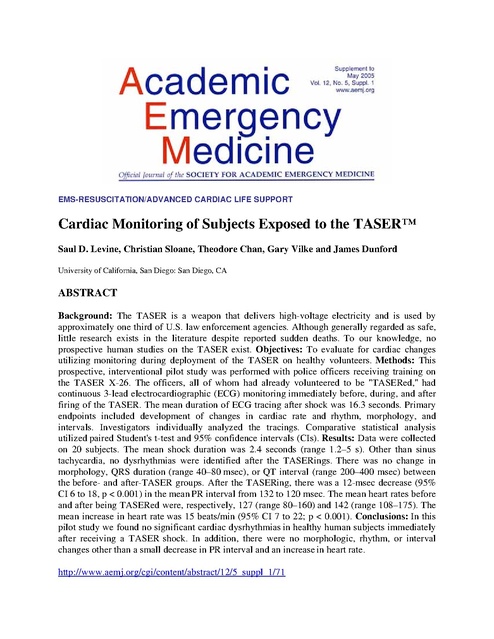Taser Cardiac Monitoring of Subjects Exposed to Taser Academic Emergency Medicine 2005
Download original document:

Document text

Document text
This text is machine-read, and may contain errors. Check the original document to verify accuracy.
EMS-RESUSCITATION/ADVANCED CARDIAC LIFE SUPPORT Cardiac Monitoring of Subjects Exposed to the TASER™ Saul D. Levine, Christian Sloane, Theodore Chan, Gary Vilke and James Dunford University of California, San Diego: San Diego, CA ABSTRACT Background: The TASER is a weapon that delivers high-voltage electricity and is used by approximately one third of U.S. law enforcement agencies. Although generally regarded as safe, little research exists in the literature despite reported sudden deaths. To our knowledge, no prospective human studies on the TASER exist. Objectives: To evaluate for cardiac changes utilizing monitoring during deployment of the TASER on healthy volunteers. Methods: This prospective, interventional pilot study was performed with police officers receiving training on the TASER X-26. The officers, all of whom had already volunteered to be "TASERed," had continuous 3-lead electrocardiographic (ECG) monitoring immediately before, during, and after firing of the TASER. The mean duration of ECG tracing after shock was 16.3 seconds. Primary endpoints included development of changes in cardiac rate and rhythm, morphology, and intervals. Investigators individually analyzed the tracings. Comparative statistical analysis utilized paired Student's t-test and 95% confidence intervals (CIs). Results: Data were collected on 20 subjects. The mean shock duration was 2.4 seconds (range 1.2–5 s). Other than sinus tachycardia, no dysrhythmias were identified after the TASERings. There was no change in morphology, QRS duration (range 40–80 msec), or QT interval (range 200–400 msec) between the before- and after-TASER groups. After the TASERing, there was a 12-msec decrease (95% CI 6 to 18, p < 0.001) in the mean PR interval from 132 to 120 msec. The mean heart rates before and after being TASERed were, respectively, 127 (range 80–160) and 142 (range 108–175). The mean increase in heart rate was 15 beats/min (95% CI 7 to 22; p < 0.001). Conclusions: In this pilot study we found no significant cardiac dysrhythmias in healthy human subjects immediately after receiving a TASER shock. In addition, there were no morphologic, rhythm, or interval changes other than a small decrease in PR interval and an increase in heart rate. http://www.aemj.org/cgi/content/abstract/12/5_suppl_1/71





